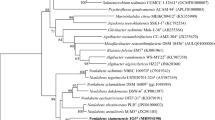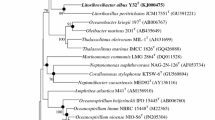Abstract
A Gram-stain-negative, non-pigmented, curved rod-shaped, single polarly flagellated, facultatively anaerobic bacterium, designated as SSH23T, was isolated from surface seawater sample collected at the Sehwa Beach in South Korea. The novel isolate required NaCl for growth and grew optimally between 2 and 3% NaCl. Strain SSH23T showed high 16S rRNA gene sequence similarities with Reinekea marinisedimentorum DSM 15388T (96.4%), Reinekea marina KACC 17315T (96.2%), Reinekea blandensis KACC 17315T (95.9%) and Reinekea aestuarii KCTC 22813T (95.6%). The major polar lipids of strain SSH23T were phosphatidylethanolamine, diphosphatidylglycerol and phosphatidylglycerol. The major cellular fatty acids of strain SSH23T were C16:0, summed feature 3 (C16:1 ω7c and/or C16:1 ω6c), and summed feature 8 (C18:1 ω7c and/or C18:1 ω6c). The predominant respiratory quinone was found to be ubiquinone-8. The average nucleotide identity values of strain SSH23T with R. marinisedimentorum DSM 15388T and R. blandensis MED297T were determined to be 72.2% and 69.8%, respectively. The G+C content of the genomic DNA was 45.5 mol%. Based on genotypic, phenotypic, chemotaxonomic, and phylogenetic analyses, strain SSH23T was considered to represent a novel member of the genus Reinekea, for which the name Reinekea thalattae sp. nov. is proposed. The type strain of Reinekea thalattae is SSH23T (= KACC 21168T = NBRC 113795T).


Similar content being viewed by others
References
Romanenko LA, Schumann P, Rohde M, Mikhailov VV, Stackebrandt E (2004) Reinekea marinisedimentorum gen. nov., sp. nov., a novel Gammaproteobacterium from marine coastal sediments. Int J Syst Evol Microbiol 54:669–673
Kang H, Kim H, Joung Y, Joh K (2015) Reinekea marina sp. nov., isolated from seawater, and emended description of the genus Reinekea. Int J Syst Evol Microbiol 66:360–364
Parte AC (2018) LPSN - List of prokaryotic names with standing in nomenclature (bacterio.net), 20 years on. Int J Syst Evol Microbiol 68:1825–1829
Pinhassi J, Pujalte MJ, Macián MC, Lekunberri I, González JM, Pedrós-Alió C, Arahal DR (2007) Reinekea blandensis sp. nov., a marine, genome-sequenced gammaproteobacterium. Int J Syst Evol Microbiol 57:2370–2375
Choi A, Cho JC (2010) Reinekea aestuarii sp. nov., isolated from tidal flat sediment. Int J Syst Evol Microbiol 60:2813–2817
Kuhsner DJ, Kamekura M (1988) Physiology of halophilic eubacteria. In: Rodriguez-Valera F (ed) Halophilic bacteria. CRC Press, Boca Raton, pp 109–138
Kim J, Chhetri G, Kim I, Kim H, Kim MK, Seo T (2019) Methylobacterium terrae sp. nov., a radiation-resistant bacterium isolated from gamma ray-irradiated soil. J Microbiol 57:959–966
Kim I, Kim J, Chhetri G, Seo T (2019) Flavobacterium humi sp. nov., a flexirubin-type pigment producing bacterium, isolated from soil. J Microbiol 57:1079–1085
Yoon SH, Ha SM, Kwon S, Lim J, Kim Y, Seo H, Chun J (2017) Introducing EzBioCloud: a taxonomically united database of 16S rRNA and whole genome assemblies. Int J Syst Evol 67:1613–1617
Altschul SF, Madden TL, Schaffer AA, Zhang J, Zhang Z, Miller W, Lipman DJ (1997) Gapped BLAST and PSI-BLAST: a new generation of protein database search programs. Nucleic Acids Res 25:3389–3402
Kumar S, Stecher G, Tamura K (2016) MEGA7: molecular evolutionary genetics analysis version 7.0 for bigger datasets. Mol Biol Evol 33:1870–1874
Larkin MA, Blackshields G, Brown NP et al (2007) Clustal W and clustal X version 2.0. Bioinformatics 23:2947–2948
Kimura M (1980) A simple method for estimating evolutionary rates of base substitutions through comparative studies of nucleotide sequences. J Mol Evol 16:111–120
Saitou N, Nei M (1987) The neighbor-joining method: a new method for reconstructing phylogenetic trees. Mol Biol Evol 4:406–425
Felsenstein J (1985) Confidence limits on phylogenies: an approach using the bootstrap. Evolution 39:783–791
Bankevich A, Nurk S, Antipov D et al (2012) SPAdes: a new genome assembly algorithm and its applications to single-cell sequencing. J Comput Biol 19:455–477
Aziz RK, Bartels D, Best AA et al (2008) The RAST server: rapid annotations using subsystems technology. BMC Genomics 9:75. https://doi.org/10.1186/1471-2164-9-75
Parks DH, Imelfort M, Skennerton CT, Hugenholz P, Tyson GW (2014) Assessing the quality of microbial genomes recovered from isolates, single cells, and metagenomes. Genome Res 25:1043–1055
Blin K, Shaw S, Steinke K, Villebro R, Ziemert N, Lee SY, Medema MH, Weber T (2019) antiSMASH 5.0: updates to the secondary metabolite genome mining pipeline. Nucleic Acids Res 47:81–87. https://doi.org/10.1093/nar/gkz310
Yoon SH, Ha SM, Lim JM, Kwon SJ, Chun J (2017) A large-scale evaluation of algorithms to calculate average nucleotide identity. Antonie Van Leeuwenhoek 110:1281–1286
Na SI, Kim YO, Yoon SH, Ha SM, Baek I, Chun J (2018) UBCG: Up-to-date bacterial core gene set and pipeline for phylogenomic tree reconstruction. J Microbiol 56:280–285
Buck JD (1982) Nonstaining (KOH) method for determination of Gram reactions of marine bacteria. Appl Environ Microbiol 44:992–993
Bernardet JF, Nakagawa Y, Holmes B, Subcommittee on the taxonomy of Flavobacterium, and Cytophaga-like bacteria of the International Committee on Systematics of Prokaryotes (2002) Proposed minimal standards for describing new taxa of the family Flavobacteriaceae and emended description of the family. Int J Syst Evol Microbiol 52:1049–1070
Chhetri G, Yang D, Choi J, Kim H, Seo T (2019) Flavobacterium edaphi sp. nov., isolated from soil from Jeju Island Korea. Arch Microbiol 201:539–545
Kuykendall LD, Roy MA, O'Neill JJ, Devine TE (1988) Fatty acids, antibiotic resistance and deoxyribonucleic acid homology groups of Bradyrhizobium japonicum. Int J Syst Evol Microbiol 38:358–361
Hiraishi A, Ueda Y, Ishihara J, Mori T (1996) Comparative lipoquinone analysis of influent sewage and activated sludge by highperformance liquid chromatography and photodiode array detection. J Gen Appl Microbiol 42:457–469
Collins MD, Jones D (1981) Distribution of isoprenoid quinone structural types in bacteria and their taxonomic implication. Microbiol Rev 45:316–354
Komagata K, Suzuki KI (1988) 4 Lipid and cell-wall analysis in bacterial systematics. Methods Microbiol 19:161–207
Lee I, Kim YO, Park SC, Chun J (2016) OrthoANI: An improved algorithm and software for calculating average nucleotide identity. Int J Syst Evol Microbiol 66:1100–1103. https://doi.org/10.1099/ijsem.0.00760
Acknowledgements
This work was supported by a grant from the National Institute of Biological Resources (NIBR), funded by the Ministry of Environment (MOE) of the Republic of Korea (NIBR202002203), and by the National Research Foundation of Korea (NRF) grant funded by the Korea government (MSIT) (2020R1F1A1072647).
Author information
Authors and Affiliations
Contributions
IK isolated the bacterium, designed the study, performed the phenotypic and biochemical characterization, wrote the original draft; GC, JK and MK helped the analysis of taxonomic data; TS designed and supervised the study, edited the original draft.
Corresponding author
Ethics declarations
Conflict of interest
The authors declare that they have no conflicts of interest.
Additional information
Publisher's Note
Springer Nature remains neutral with regard to jurisdictional claims in published maps and institutional affiliations.
Electronic supplementary material
Below is the link to the electronic supplementary material.
Rights and permissions
About this article
Cite this article
Kim, I., Chhetri, G., Kim, J. et al. Reinekea thalattae sp. nov., a New Species of the Genus Reinekea Isolated from Surface Seawater in Sehwa Beach. Curr Microbiol 77, 4174–4179 (2020). https://doi.org/10.1007/s00284-020-02224-8
Received:
Accepted:
Published:
Issue Date:
DOI: https://doi.org/10.1007/s00284-020-02224-8




